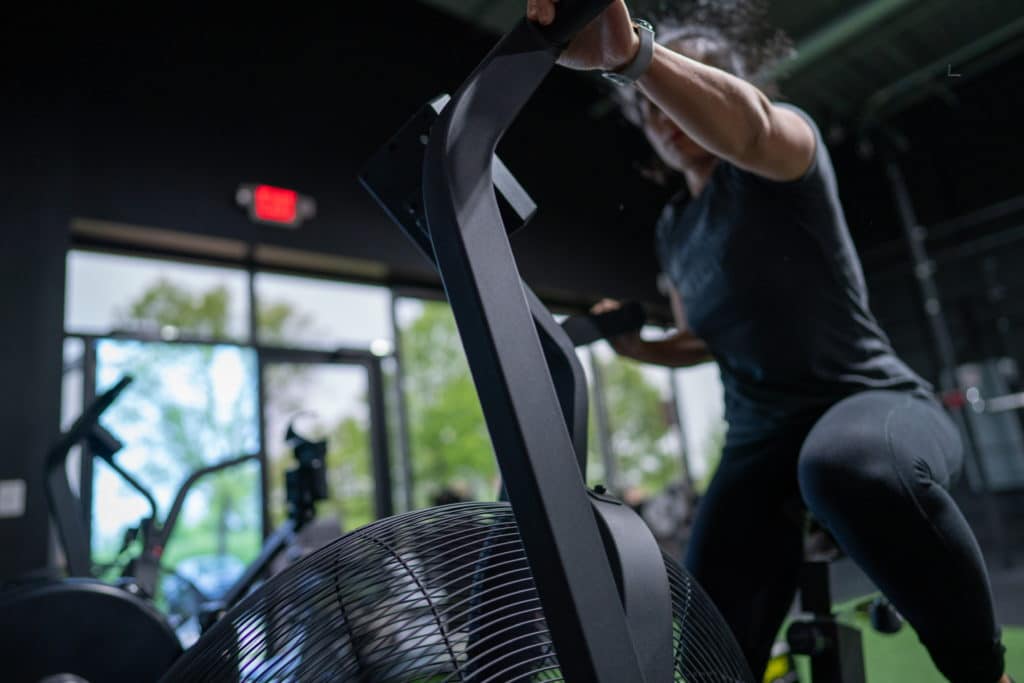Fitness marketing has people obsessed with the burn, the sweat, the feeling that you’re going to black out in a pool of your own fluids. They sell you on things like the “afterburn” of excess post-exercise oxygen consumption (EPOC). And to achieve it, you have to work so hard you piss down your leg while sobbing. They lead you to believe that you won’t get results if you don’t work that hard during every workout. I bet you already guessed that I’m about to tell you it ain’t so.
Well, it ain’t so.
The truth is that we don’t need much intense conditioning to make progress. And instead of concerning ourselves with how much oxygen we consume after exercise, our mental bandwidth is better spent on designing workouts that teach our body to utilize oxygen while training. So, let’s talk about that.
Next month’s Beyond Strength training program includes V02Max intervals. We want to give you the why behind the spice, so you get it. But we also want to give you the knowledge to call bullshit when necessary.
Let’s party.
What is V02Max?
It’s best that we begin with a definition:
V02Max is the maximum rate of oxygen consumption during exercise. That means how much and how quickly oxygen is delivered to and utilized by working muscles. You want your V02Max to be as high as possible. It’s correlated to cardiovascular health and longevity. And having a high V02Max is indicative of great aerobic fitness and endurance.
While we all want that spice, and V02Max intervals improve our maximum oxygen utilization, there is groundwork to lay before jumping into this kind of training.
V02Max Training: What Comes First?
V02Max intervals are done at near-max intensity – that means as hard as you can f*cking work. You can’t just jump into that kind of smoke. There’s base building to do first. You need structural aerobic adaptations, muscular strength, and muscular endurance, before you train your V02Max.
Structural aerobic adaptations elicited by low to moderate intensity conditioning are necessary for maximal oxygen delivery to working muscles. Your heart pumps out more blood with each beat. The capillary beds in your muscles get denser. You actually increase your blood volume. That’s right, you get more blood. All of these adaptations improve your oxygen delivery system; they’re pre-reqs for increasing the rate of oxygen consumption during exercise. It takes at least a few months of base-building with this type of training before you’re ready for V02Max intervals.
We also have to prepare our bodies to work at and sustain high intensity. That’s where muscular strength and muscular endurance come in. If you can’t generate a lot of force, you won’t be able to expend the effort necessary to generate enough intensity. If you don’t have the muscular endurance to sustain that effort, you won’t work for long enough to push your oxygen consumption.

During the first half of this year, we’ve done a ton of aerobic capacity building, strength training, and muscular endurance training. And we’ve done it in multiple ways – from the 100 rep strength workouts during our first training block to the threshold training we’re currently doing.
This month we’re doing 12-minute lactate threshold/tempo intervals. These intervals train the body to work at lactate threshold, which is the point at which lactate accumulates and causes the body to fatigue. Lactate threshold intervals train the body to clear lactate and recycle it for use in energy production to sustain aerobic metabolism. Doing this type of training before V02Max training improves our muscular endurance as well as improves aerobic endurance at higher intensities. It preps us well for sustained maximal intensity conditioning.
V02Max Intervals: What They are and How We’re Doing Them
Alrighty. Before we go any further, I want you to know that V02Max training is uncomfortable. You’re going to work at 9 out of 10 on the intensity scale and maintain that effort for at least 3 minutes. Now you know.
V02Max intervals are typically done in a 1:1 work to rest ratio, with each interval lasting between 3 and 5 minutes. This set up allows you to work for long enough to increase your body’s need for oxygen while also giving you enough time to recover between work intervals. You’ll also accumulate fatigue during the workout that increases your body’s need for oxygen uptake.
The workouts aren’t long. They can’t be because they place a ton of load on your body. It’s also unnecessary to make them long. You only need a handful of intervals to elicit the adaptations, which are improving mitochondrial efficiency, enzymatic activity, and boosting myoglobin concentrations.

We’re doing three- to four-minute work intervals followed by the same amount of rest. During those work intervals we’re combining a cyclical cardio movement (ski-erg, bike, or rower) with different athletic movements like crawling, hopping, etc.
But first we’re doing a 15-minute cardio warm-up. This helps us prep for the intensive work by increasing blood flow and aerobic enzymatic activity.
And we’re only doing this workout once per week for four weeks. This isn’t the type of training you do more than once per week or for extended periods of time. (More on that in the next section.)
It’ll be spicy, but productive.
The Dangers of V02Max Training
It’s addictive for several reasons.
The hard effort hits us with a big dopamine rush. That feels really good when we finish training, and it makes us want to do it more than we should.

Chris’s note: I’ve never wanted to repeat Vo2Max intervals for longer than ONE week, let alone three ha! I think Todd’s on crack with that last line!
Adaptations to V02Max training also happen fast. Some of them happen within hours of a training session. So, we feel our fitness improve quickly. That also feels good.
The problem is it places a lot of load on the body. That means stress. All that stress accumulates and will lead to a plateau or backslide if you aren’t careful. Continually pushing the intensity can also lead to injuries.
So, if you’re not already a Beyond Strength member and you want to include it in your training plan, be sure that you’ve done a ton of aerobic capacity training first. Also, make sure you have a solid strength base, you’ve done a few months of muscular endurance training, and you’ve done some lactate threshold work.
Once you’ve done all that, go on with your bad self and do some V02Max intervals.
Just don’t do them more than once per week, and don’t do them for more than a month or so at a time.
V02Max training is a smart way to improve your fitness. Just don’t be stupid with it like those folks that try to make you piss yourself for EPOC. 🙂
You might also like:
- YESTERDAY DON’T MEAN SH*T
- WHY YOUR HEART RATE JUMPS DURING PLYOS
- WANT TO MAKE PROGRESS? PUT SOMETHING HARD ON THE CALENDAR
- STRENGTH LOVES REST: WHY YOU NEED LONGER REST PERIODS TO BUILD STRENGTH
- HOW TO RECOVER FROM YOUR WORKOUTS
- WHY IT’S IMPORTANT TO COOL DOWN AFTER TRAINING
- MORPHEUS HEART RATE TRAINING: WHAT IT IS, WHY WE USE IT, AND HOW YOU CAN GET THE MOST OUT OF IT
- START NOW: WHY WAITING FOR THE PERFECT TIME IS THE WORST THING TO DO
- HOW (AND WHY) OUR YEAR-LONG TRAINING PLAN WORKS
- WHY WE TEST AT BEYOND STRENGTH
- TIPS FOR COMPETING WITH YOURSELF IN THE GYM
- HOW MANY REPS SHOULD YOU DO? (Spoiler alert, it matters in more ways than you think)
